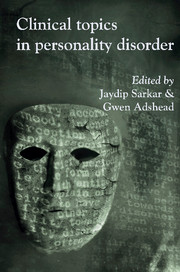Book contents
- Frontmatter
- Contents
- List of tables
- List of boxes
- List of figures
- List of contributors
- Foreword
- Part 1 The nature of the problem
- 1 The nature of personality disorder
- 2 Differences between psychopathy and other personality disorders: evidence from neuroimaging
- 3 Challenges in the treatment of dangerous and severe personality disorder
- 4 Are you looking at me? Understanding and managing paranoid personality disorder
- 5 Personality disorder in older people: how common is it and what can be done?
- 6 Management of common personality disorders in the acute setting
- 7 Personality disorder in women
- 8 Personality disorder in adolescence
- Part 2 Management and general treatment approaches
- Part 3 Specific treatment approaches
- Index
2 - Differences between psychopathy and other personality disorders: evidence from neuroimaging
from Part 1 - The nature of the problem
Published online by Cambridge University Press: 02 January 2018
- Frontmatter
- Contents
- List of tables
- List of boxes
- List of figures
- List of contributors
- Foreword
- Part 1 The nature of the problem
- 1 The nature of personality disorder
- 2 Differences between psychopathy and other personality disorders: evidence from neuroimaging
- 3 Challenges in the treatment of dangerous and severe personality disorder
- 4 Are you looking at me? Understanding and managing paranoid personality disorder
- 5 Personality disorder in older people: how common is it and what can be done?
- 6 Management of common personality disorders in the acute setting
- 7 Personality disorder in women
- 8 Personality disorder in adolescence
- Part 2 Management and general treatment approaches
- Part 3 Specific treatment approaches
- Index
Summary
Summary The ICD-10 and DSM-IV-TR diagnostic guidelines do not list psychopathy as a distinct psychiatric entity. However, there are significant overlaps between psychopathy and DSM-IV-TR cluster B personality disorders. Neuroimaging studies implicate deficits in the structure and function of frontal and limbic regions in this group of personality disorders, while highlighting both distinctions and overlaps between syndromes. In this chapter, these data are reviewed, and implications for diagnosis and clinical practice are discussed.
In his influential book The Mask of Sanity, Hervey Cleckley presented a series of vignettes which distilled typical features of large numbers of individuals with psychopathy whom he had interviewed (Cleckley, 1941). He described them as charming, callous and superficial, commenting that their lack of conscience or genuine emotion was camouflaged by the ‘mask’ of a healthy, functional individual. People with psychopathy commit a large amount and wide variety of violent and non-violent crimes, and are resistant to attempts at rehabilitation (Reid & Gacono, 2000). The definition of psychopathy has changed little since Cleckley's time, and the aetiology of the condition remains unknown.
Psychopathy shares general features with personality disorders listed in DSM-IV-TR (American Psychiatric Association, 2000), even though it is not included among them. Personality disorders comprise a group of disorders that usually result in impaired interpersonal functioning. Individuals exhibit enduring patterns of cognition, emotion and behaviour that deviate markedly from cultural expectations. The three clusters of personality disorders listed in DSM-IV-TR (American Psychiatric Association, 2000) fall under the headings ‘odd–eccentric’ (cluster A), ‘emotional–dramatic’ (cluster B) and ‘anxious–fearful’ (cluster C), and each contains further subtypes.
Reclassification of psychopathy
Psychopathy as a distinct psychiatric condition disappeared from diagnostic classifications with the publication of DSM-III (American Psychiatric Association, 1980). In DSM-IV-TR, psychopathy is called antisocial personality disorder and in ICD-10 (World Health Organization, 2004) it is dissocial personality disorder. However, although both antisocial and dissocial personality disorders include several traits reflecting psychopathic personality (for example, lack of guilt/remorse, impulsivity), it is possible to meet the diagnostic criteria for these disorders solely on the basis of the behavioural manifestations of antisocial behaviour (for example, violation of social norms, irresponsibility, criminality).
- Type
- Chapter
- Information
- Clinical Topics in Personality Disorder , pp. 21 - 37Publisher: Royal College of PsychiatristsPrint publication year: 2012



